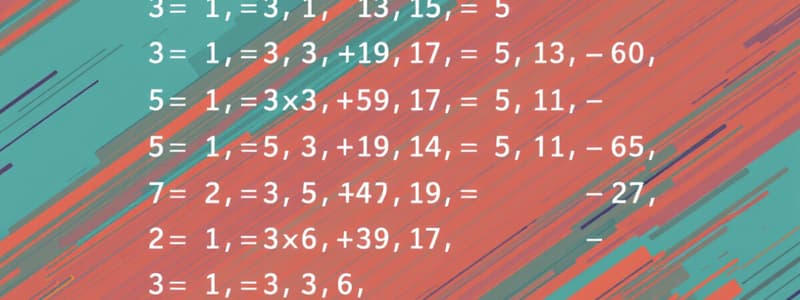Podcast
Questions and Answers
What will the value of x be after executing the code segment where int x = 4; int y = 6; x -= y; y += x;
What will the value of x be after executing the code segment where int x = 4; int y = 6; x -= y; y += x;
- 6
- 4
- 2
- -2 (correct)
What will be the value of y after the given code segment is executed?
What will be the value of y after the given code segment is executed?
- 6
- 8 (correct)
- 4
- 0
Which statement accurately describes the change in variable values after code execution?
Which statement accurately describes the change in variable values after code execution?
- x decreased and y increased. (correct)
- x has not changed and y has increased.
- Both x and y have decreased.
- Both x and y have increased.
What will happen if you try to assign an int value to a double variable in the code segment?
What will happen if you try to assign an int value to a double variable in the code segment?
Which of the following statements is true regarding the behavior of double and int division?
Which of the following statements is true regarding the behavior of double and int division?
If x is initially 4 and y is 6, what expression would result in their values switching?
If x is initially 4 and y is 6, what expression would result in their values switching?
In the provided code, after executing the operations, what is the final relationship between x and y?
In the provided code, after executing the operations, what is the final relationship between x and y?
Why does the code segment not compile if a double value is used improperly in a division?
Why does the code segment not compile if a double value is used improperly in a division?
What is printed as a result of executing the code segment: double d = 0.25; int i = 3; double diff = d - i; System.out.print((int)diff - 0.5);?
What is printed as a result of executing the code segment: double d = 0.25; int i = 3; double diff = d - i; System.out.print((int)diff - 0.5);?
What is the output of the code segment: double a = 7; int b = (int) (a / 2); double c = (double) b / 2; System.out.print(b); System.out.print(' '); System.out.print(c);?
What is the output of the code segment: double a = 7; int b = (int) (a / 2); double c = (double) b / 2; System.out.print(b); System.out.print(' '); System.out.print(c);?
What will be printed from the following code: double p = 10.6; double n = -0.2; System.out.println((int) (p + 0.5)); System.out.print((int) (n - 0.5));?
What will be printed from the following code: double p = 10.6; double n = -0.2; System.out.println((int) (p + 0.5)); System.out.print((int) (n - 0.5));?
Which of the following values will be output from executing this code segment: System.out.print((int)(3.99 + 0.5));?
Which of the following values will be output from executing this code segment: System.out.print((int)(3.99 + 0.5));?
What does the following code produce: double m = 12.8; System.out.println((int)m);?
What does the following code produce: double m = 12.8; System.out.println((int)m);?
What will be printed by executing: double x = 4.6; int y = (int)(x - 0.6); System.out.print(y);?
What will be printed by executing: double x = 4.6; int y = (int)(x - 0.6); System.out.print(y);?
How will the following code behave: System.out.println((int)(-2.5));?
How will the following code behave: System.out.println((int)(-2.5));?
What is the outcome of executing: int a = 5; double b = a / 2; System.out.println(b);?
What is the outcome of executing: int a = 5; double b = a / 2; System.out.println(b);?
What correction can be applied to ensure the code segment works as intended for certain values of len1, len2, and len3?
What correction can be applied to ensure the code segment works as intended for certain values of len1, len2, and len3?
Which of the following would cause the code segment to not work as intended?
Which of the following would cause the code segment to not work as intended?
Why might declaring minLength as a double be relevant for the code segment?
Why might declaring minLength as a double be relevant for the code segment?
What is the consequence of not casting len1, len2, and len3 to int before adding them?
What is the consequence of not casting len1, len2, and len3 to int before adding them?
How can the code ensure that it works for all possible values of len1, len2, and len3?
How can the code ensure that it works for all possible values of len1, len2, and len3?
What is a potential issue with declaring minLength as an int?
What is a potential issue with declaring minLength as an int?
Which statement correctly describes the requirements for variable types in the code segment?
Which statement correctly describes the requirements for variable types in the code segment?
What happens when the code does not account for different data types for len1, len2, and len3?
What happens when the code does not account for different data types for len1, len2, and len3?
What is the expected output of the given code segment when it is fixed?
What is the expected output of the given code segment when it is fixed?
Which change would fix the issue in the assignment of fact1?
Which change would fix the issue in the assignment of fact1?
What error results from the current declaration of fact1?
What error results from the current declaration of fact1?
How should '3 * 4' be correctly represented to ensure accurate calculations?
How should '3 * 4' be correctly represented to ensure accurate calculations?
What will happen if both 1 and 2 in '1 / 2' are declared as integers?
What will happen if both 1 and 2 in '1 / 2' are declared as integers?
If fact1 is corrected to be calculated as a double, what would the expression for product be without other changes?
If fact1 is corrected to be calculated as a double, what would the expression for product be without other changes?
What should happen after correctly adjusting the fact1 declaration?
What should happen after correctly adjusting the fact1 declaration?
In what order does the multiplication and division execute in relation to the code segment provided?
In what order does the multiplication and division execute in relation to the code segment provided?
What is the value of minLength when len1 is 1.1, len2 is 3.2, and len3 is 2?
What is the value of minLength when len1 is 1.1, len2 is 3.2, and len3 is 2?
Which statement accurately describes the code segment's intended behavior?
Which statement accurately describes the code segment's intended behavior?
What conversion is performed before calculating minLength?
What conversion is performed before calculating minLength?
When will the code segment display a value of 11?
When will the code segment display a value of 11?
What value does the expression (total + 0.5) serve in the code segment?
What value does the expression (total + 0.5) serve in the code segment?
What is the primary limitation of the code segment regarding input values?
What is the primary limitation of the code segment regarding input values?
What type of rounding does the code segment use to determine minLength?
What type of rounding does the code segment use to determine minLength?
How does the code treat the decimal part of the total when it is less than 0.5?
How does the code treat the decimal part of the total when it is less than 0.5?
Study Notes
Compilation Issues
- Code segments fail to compile when assigning
intvalues todoublevariables or when dividingdoublevalues byintvalues.
Code Behavior Analysis
- For the code segment with
int x = 4; int y = 6;:- x is decreased by y, altering its value negatively.
- y is increased by the new value of x, resulting in both variables changing.
Output from Arithmetic Operations
- Code segment with
double d = 0.25; int i = 3;:- Calculation results in
diffbeing negative, with the printed output being-2.5.
- Calculation results in
More Arithmetic Outputs
- Code segment
double a = 7; int b = (int) (a / 2);:- Outputs
3forband1.0forc, combining integer and double prints.
- Outputs
Output with Mixed Types
- Code segment with
double p = 10.6; double n = -0.2;:- Prints
11from the first calculation and-1from the second, showing how type conversion impacts output.
- Prints
Intended Functionality of Length Calculation
- A code segment calculating the total length from three lengths aims for a correct integer representation:
- Works correctly for all nonnegative lengths.
- This segment fails if the sum does not align with adding 0.5 appropriately before casting.
Error Analysis in Factorial Calculation
- Code segment for calculating a product fails to yield 6.0 due to incorrect integer division:
- The fraction
1 / 2provides0in integer context; hence it must be cast todoublefor correct output.
- The fraction
- Both
fact1andfact2must convert their operations todoublefor correct calculations.
Summary of Key Points
- Understanding variable types and conversions is crucial to prevent compilation errors.
- Performing arithmetic operations on mixed data types impacts output and requires awareness of type casting.
- Program behavior often hinges on maintaining the correct use of data types, especially in division and summation contexts.
Studying That Suits You
Use AI to generate personalized quizzes and flashcards to suit your learning preferences.
Related Documents
Description
This quiz explores the behavior of different data types in programming, specifically focusing on integers and doubles. Analyze compilation issues, arithmetic operations, and the impact of type conversions on output values. Perfect for students learning to navigate data type interactions in code.




